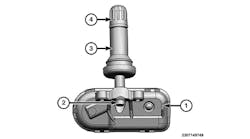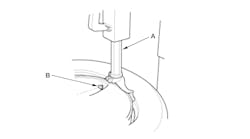As engine technologies evolve, critical engine components will continue to come under increasing amounts of stress.
Bill Beyerle, automotive installed manager for Chevron Corp., says “newer engines are smaller, have tighter tolerances between engine parts and run at higher temperatures.”
These advancements are ideal for increasing fuel efficiency and providing maximum power to drivers, but they cause “incredibly high stressors inside the engine,” he adds.
As a result, there’s a need for engine oil to perform better to keep motors well-protected and working optimally.
Experts say tire dealers should take note of shifting trends in engine oil technology, interval times between oil and lube changes and best practices for customer communication.
Seventy-two percent of respondents to MTD’s latest Tire Dealer Automotive Service Survey offer engine oil and lube services to customers.
Influencing factors
Evolving engine technologies have spurred a strong shift toward full-synthetic formulations, according to Beyerle.
He says rapid changes in motor technology are being forced by four factors: changes in government regulations, pressure to reduce emissions, a focus on fuel economy and “the need for speed.”
There also has been a big push toward smaller engines.
“Today’s six-cylinder engines produce as much power as eight-cylinder engines from the previous generation and the current four-cylinder engines outperform earlier six-cylinder counterparts,” says Beyerle.
“Improved engine oils can protect all parts of a small, turbo-charged (gasoline direct injected) engine that runs hotter, experiences more stress and has a high-power density. That is why OEMs have started using and recommending synthetic oils of ever-thinner viscosities because they reduce friction and protect the engine.”
Other key trends
Brian Yates, product engineering director at Mann + Hummel, the makers of WIX Filters, Purolator and Mann-Filter, says low-viscosity engine oils “reduce the energy required to pump lubricant through the engine, while at the same time dissipating heat and contaminants and improving fuel efficiency.
Beyerle says that “over the past two years, more than 90% of new vehicles coming off the assembly line have been factory-filled with full synthetic oils and the market anticipates that roughly 90% of vehicles on the road will require full synthetic by 2030.”
Shawn Swaverly, senior marketing manager at Amsoil, shares insight into these other market patterns:
Lower ash content. “Along with fuel economy regulations, tailpipe emissions continue to tighten,” he notes. “To help meet these increasingly strict requirements, industry standards have reduced the allowable ash content in engine oils. Ash is commonly used in detergent packages to clean and prevent deposit buildup. However, in the not-too-distant future, gasoline particulate filters will be employed and under certain conditions, the ash can reduce the efficiency and longevity of that system.”
Low-speed pre-ignition (LSPI). This is a relatively new concern, according to Swaverly. “It’s a catastrophic event that can occur in modern turbo-charged, direct injection engines operating under low-speed, high-load conditions, such as accelerating from a stoplight. This form of pre-ignition is particularly destructive as cylinder pressures continue to increase with forced induction. Some engine oil chemistries can actually promote pre-ignition, so choosing the right engine oil is important to help prevent LSPI.”
Segmentation. “Not all powertrains are the same nor do they experience the same conditions. Ensuring the longest life for (vehicles) requires using specialized lubricants formulated for the specific operating conditions of that application.”
The next big thing
Donald Chilton, director of product management at Mann + Hummel, says tolerances in engines have grown tighter “and you see the movement of 0W oils becoming the go-to for engine manufacturers.”
He expects this will continue. “Lower weights will still grow in popularity and synthetics, as well. The oil packages will continue to see refinement. Battery electric vehicles are not taking off as fast” as originally expected. “And hybrid (vehicle) investments are now ramping up.”
Bo Barnhill, engine oil product development engineer at Chevron, adds that “there is an increasing demand for products that are environmentally sustainable and eco-friendly. The immediate next big thing is to develop better oils to not only provide longer protection of engine parts, but also provide better fuel economy.
“This is what synthetic and lower-viscosity oils are doing today,” he explains. “Next-gen engine oils will need to stand up to the rigorous requirements of newly developed engines and specifications, while also minimizing environmental impact.
“The introduction of premium, bio-based oils and the increasing quality of re-refined oils will have a significant positive impact on the environment.
“Additionally, these next-gen engine oils must be compatible with new exhaust after-treatment systems, like gasoline particulate filters, to enable significant reduction of harmful exhaust particulates.”
Swaverly says he expects “more of the same” in terms of new technology and future developments, adding that “engine oils are more of an evolution than a revolution due to the backward compatibility. Therefore, maintaining protection with lower viscosities and lower ash levels will continue to be the theme.”
New engine oil formulas also are extending interval times, according to Barnhill. “It used to be normal to change oil every 3,000 miles, but with modern lubricants most engines today have recommended oil change intervals of 5,000 to 7,500 miles.”
Yates says that extended intervals “makes it important from a filter selection process perspective to utilize high-grade elastomers and medias versus using the lowest-cost replacement.”
Communicating changes
Keeping customers up-to-date on engine oil technology and evolving service intervals is important.
“Most vehicle owners understand that oil change intervals have evolved,” says Barnhill. “However, they might be unsure on what is the recommended interval for their vehicle. Many use on-board oil life monitoring systems that alert them about when they should change their oil. When the light on the dash comes on, they know to head to their local quick lube or dealership.”
That on-board alert that prompts a visit can be a great lead-in to conversations that cover service recommendations or topics not addressed in the vehicle owner’s manual.
“Changing oil isn’t just about the miles driven,” says Barnhill. For example, “oil becomes less effective as it ages and if you do not get the engine warm enough with longer drives, excess moisture that forms in the engine will not be removed which can lead to shorter engine life, especially for hybrid vehicles.”






